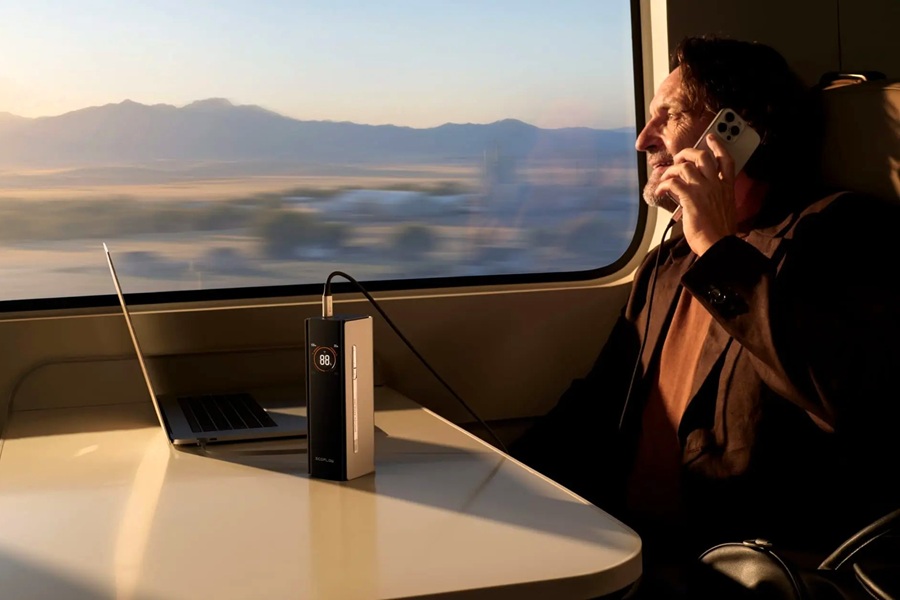How to choose a power bank for your laptop or phone
Having a reliable power bank ensures that your laptop and phone never run out of juice when you need them most
IN TODAY’S MOBILE world, staying powered up has become more important than ever. Whether you’re working remotely from a café, flying across Canada, or camping in the Rockies, having a reliable power bank ensures that your laptop and phone never run out of juice when you need them most.
But with so many different models, capacities, and charging technologies available, how do you choose the right one? This guide will help you understand the key factors to consider before buying a power bank for your laptop or phone.
1. Know Your Power Needs
The first step is to understand how much power your devices require. Smartphones typically need between 10 to 30 watts for fast charging, while laptops may need anywhere from 45 to 100 watts or more.
When checking a power bank’s specifications, look for its output wattage (W) and capacity in watt-hours (Wh). The wattage determines how fast it can charge your device, and the watt-hour rating shows how much total energy it can store.
- For phones and tablets: a 20–30W power bank with at least 10,000 mAh capacity is usually enough.
- For laptops: look for a 60–100W output and 20,000–27,000 mAh (≈ 100 Wh) capacity model.
Choosing a power bank with higher wattage ensures you can charge multiple devices at once without slowing down the charging speed.
2. Check the Output Ports
The type and number of output ports matter more than you might think.
- USB-C Power Delivery (PD) ports are the gold standard for modern devices. They can handle both high-speed charging for laptops and adaptive charging for phones.
- USB-A ports are still useful for older devices, but they don’t support the same high-power output.
- Some advanced power banks also offer DC outputs for cameras or routers.
If you often charge your laptop and phone together, look for a multi-port power bank that can deliver at least one 60–100 W USB-C PD output and another 20 W USB-A or USB-C port.

3. Consider Capacity vs. Portability
Bigger isn’t always better. While a 100 Wh power bank can keep your laptop running for hours, it will also be heavier.
For example:
- 10,000 mAh models are compact and perfect for smartphones.
- 20,000–27,000 mAh models balance capacity and portability, ideal for both phones and laptops.
- Anything above 30,000 mAh tends to be bulky and often exceeds airline limits.
In Canada (and most international airlines), you can bring a power bank up to 100 Wh in your carry-on baggage. Anything above that usually requires airline approval.
So if you travel frequently, choosing a power bank under 100 Wh gives you maximum flexibility.
4. Understand Charging Speed
Not all fast chargers are created equal. Look for power banks that support PD 3.0 (Power Delivery) or QC 4.0 (Quick Charge) standards, as they ensure faster and more efficient charging for modern devices.
For laptops like MacBook Air or Dell XPS, a 60 W PD output is usually enough. High-performance laptops might need up to 100 W.
Some power banks also support bi-directional USB-C charging, which allows them to recharge themselves rapidly—often from 0 to 80% in less than an hour when paired with a fast wall adapter.
If you often charge on the go, this feature is a huge time-saver.
5. Check Battery Type and Safety Features
Battery chemistry plays a major role in performance and safety.
- Li-ion (Lithium-ion) batteries are common, affordable, and reliable.
- LiFePO₄ (Lithium Iron Phosphate) batteries are becoming more popular thanks to their stability, longer lifespan, and better heat resistance.
Also, make sure the power bank includes built-in safety protections such as:
- Overcharge and over-discharge protection
- Temperature monitoring
- Short-circuit protection
- Overcurrent and surge protection
These ensure your devices and the power bank itself stay safe, especially during long trips or extreme temperatures.

6. Look for Smart Features
Modern power banks are more than just portable batteries. Some now include features like:
- Digital displays showing remaining power percentage or output wattage
- Pass-through charging, allowing you to charge the power bank while it powers your devices
- Wireless or magnetic charging, useful for phones and earbuds
- Integrated cables, so you don’t have to carry extra cords
While these features aren’t essential, they can make your experience much more convenient.
7. Think About Recharging Speed
One factor many buyers overlook is how fast the power bank itself recharges.
If a unit supports 100 W USB-C input, you can refill it from empty to full in about an hour with the right charger. But if it only supports 20 W input, it could take 4–6 hours or more.
So, check both the input power rating and the type of charger it supports. Investing in a matching high-wattage wall adapter ensures your backup battery is ready when you need it.
8. Build Quality and Design
Durability matters—especially if you travel or work outdoors. A well-built power bank with an aluminum shell or reinforced casing can better handle drops and temperature changes.
Consider models with:
- Anti-scratch or matte finish
- Rounded edges for easier handling
- LED indicators or digital displays
- Carrying case or protective pouch
If you’ll use it in rugged conditions, look for IP-rated designs that resist dust or water.

9. Brand Reputation and Warranty
Even though this article avoids naming specific brands, it’s worth emphasizing that warranty and customer support matter.
Choose power banks from reputable manufacturers that provide at least a 12-month warranty and clear safety certifications such as UL, CE, or FCC. In Canada, this ensures compliance with local safety standards and easier after-sales service if anything goes wrong.
10. Match the Power Bank to Your Lifestyle
Finally, think about when and how you’ll use it:
- Frequent flyers: a 27,000 mAh (≈ 100 Wh) model with 100 W output is perfect for flights and hotels.
- Students or commuters: a lighter 10,000 mAh power bank that fits in your bag for daily top-ups.
- Outdoor enthusiasts: a high-capacity model that supports multiple devices, ideally paired with a small solar panel.
- Remote workers: a fast-charging model with dual USB-C ports to keep your phone and laptop powered all day.
Matching your habits to the specifications ensures you’re not overpaying for features you don’t need—or under-equipping yourself for long trips.

